Audiometric Principles 2
Unlock all answers in this set
Unlock answersquestion
why do we mask?
answer
-determine type of HL -evaluate hearing in test ear
question
acoustic reflexes
answer
-suggest site of lesion or retrocochlear disorder -can be affected by ME disorders, HL in stimulus ear or interruption of neural innervation of stapedius muscle
question
OAEs
answer
-assess aud function up to level of OHCs
question
conductive HL
answer
-loss of hearing sensitivity caused by blockage of sound before sound gets to ear (ear canal or ME)
question
examples of CHL
answer
-wax blockage -fluid in ME -break in ossicular chain -tumor in ME
question
symptoms of CHL
answer
-sound too soft -loss worse in LF -may experience occlusion effect -sometimes hear better in loud noisy environments -medically treatable
question
treatment of perf
answer
-usually heals spontaneously -due to repeated infections--> probs won't heal on own
question
surgery option for perfs
answer
-myringoplasty=paper patch -tympanoplasty=formal skin
question
evidence of prior perf
answer
-tympanosclerosis=scarring, white patch on TM -monomeres=false TM, incomplete healing
question
cochlear HL
answer
-damage to IE -nerve impulse not generated due to loss -damage to hair cells
question
symptoms of cochlear loss
answer
*bilateral* *HF hearing affected first* -speech sound muffled -speech not always easier to hear if louder *distortion* -tinnitus -dizziness rarely present
question
what is a hallmark of cochlear loss?
answer
recruitment
question
recruitment
answer
abnormal growth of loudness -dynamic range shrinks *normal loudness perception in an impaired ear*
question
retrocochlear HL
answer
-damage to retrocochlear structure in 8th nerve or brainstem
question
symptoms of retrocochlear involvement
answer
-person has both cochlear & retro damage *unilateral* -loss mild to severe -sound distorted or unclear *tinnitus & dizziness common* -won't have recruitment -HA not appropriate
question
SNHL
answer
-can't always distinguish cochlear & retro -damage in IE & beyond
question
mixed HL
answer
-CHL component & SNHL component -can be in TM, OE, ME, retro
question
determining site of lesion
answer
-where pathology is to decide if medical eval needed -should be included in every report
question
need for medical eval
answer
-based on history, physical exam, rest results -have condition that can improve with medical treatment or worsen without treatment
question
report
answer
-every report should include prognosis -history -physical exam -test results -limitations
question
FDA criteria for medical referral
answer
-visible congenital/traumatic deformity of ear -active drainage within past 90 days -sudden/progressive HL within past 90 days -acute/chronic dizziness -pain/ discomfort in ear
question
what should we expect with normal otoscopy?
answer
Type A Tymp normal ART OAEs may not be present not conductive or mixed HL
question
physical exam of external ear
answer
-skin lesions, infection -malformations, atresia, size, growth tags -trauma, surgical scars -position/angle of pinna -stenosis/ collapsible canal
question
course of ear for otoscopy of ear canal
answer
anterior-superior, posterior, anterior inferior
question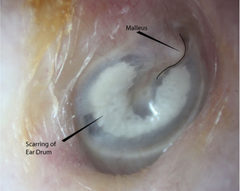
what would the test results be for scar tissue?

answer
-less compliant TM -normal or not present AR -reduced, diminished, robust OAEs -CHL, WNL
question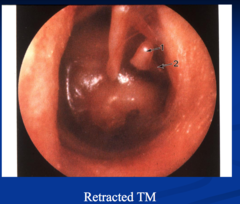
what would the test results be for TM retraction?

answer
Type B Tymp absent AR absent OAEs CHL
question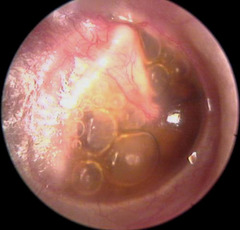
what would the test results be for otitis media?

answer
Type B tymp, reduced compliance absent or elevated AR & OAEs CHL
question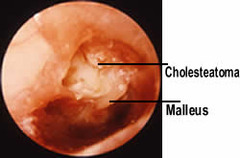
what would the test results be for cholesteatoma?

answer
-normal tymp -normal AR -normal OAEs -WNL as grows can become big problem, canal wall up or down surgery
question
glomus tumor
answer
-abnormal growth of glomus body (vein, blood vessel) -red TM -pulsatile tinnitus -refer to ENT
question
causes of TM perf
answer
-trauma -ear infection
question
ear infections causing perf
answer
-pressure of pus/fluid behind TM -repeated ME infections
question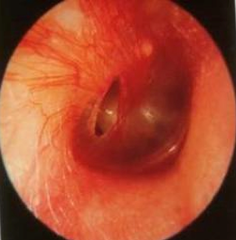
what would the test results be for perforations?

answer
-high EC volume on tymp -elevated AR -diminished/present OAEs -CHL
question
when is stenger test used?
answer
-asymmetric air conduction thresholds -questioning organic aspect to loss -estimate accurate threshold -conduct immediately upon ID for need
question
audiometric configuration needed for stenger test
answer
-asymmetric loss of at least 20dB HL -PT threshold -SRT
question
how does stenger test work?
answer
-present same signal in both ears at same time -listener will only perceive sound in ear which it is loudest or has highest SL -no patient instructions
question
stenger formula?
answer
better ear: threshold + 10 dB SL worse ear: threshold - 10 dB present stimulus to both ears at same time -either AC thresholds or speech thresholds used
question
positive stenger test
answer
-no response -can use to establish estimate or accurate threshold -patient is lying
question
negative stenger test
answer
-patient response they heard sound -patient not lying
question
masking
answer
elevation in threshold of 1 signal produced by into of 2nd signal
question
clinical masking
answer
-masking elevates threshold in NTE -want ear specific info
question
cross over and need to mask
answer
-when present signal to TE, may cross over to NTE -could result in shadow curve if left unmasked ex. ear phone leakage & BC
question
when do we need to mask?
answer
-when unmasked threshold in TE is greater than IA for transducer in use when referencing BC threshold of NTE
question
what do negative or flat tymps suggest? (type B, C, Ad)
answer
-CHL -bone thresholds better (0)
question
what do normal tymps suggest? (Type A)
answer
-SNHL -bone should match air thresholds
question
interaural attentuation
answer
-reduction in sound energy of a signal as it is transmitted by BC from 1 side of head to opposite ear -all kinds of stimuli can result in IA
question
effective masking
answer
-intensity in dBHL that a PT can be masked by given level of noise -amount of masking needed to just mask an auditory stimulus
question
under-masking
answer
-when noise presented to NTE is not sufficient to keep from contributing
question
IA for headphones
answer
40 dB
question
IA for bone vibrator
answer
0-10dB
question
IA for inserts
answer
60dB
question
sufficient masking
answer
-when noise presented to NTE is enough to keep it from contributing to response & not intense enough to influence ability of TE to respond
question
overmasking
answer
-when noise presented to NTE is intense enough to cross over to TE and mask it -causes TE thresholds to be elevated
question
masking rule
answer
-masking using NBN is needed when TE AC threshold exceeds NTE by 40dB or more -TE AC threshold exceeds NTE BC threshold by 40dB or more
question
plateau method of masking
answer
-start level= 15dB above AC threshold of NTE -determine point of overmasking -re-est AC TE threshold -raise masking noise level 5dB present test tone at new threshold -increase masking another 5 dB & present test tone at new threshold again -continue until new threshold does not change for 3 consecutive 5dB masking increments
question
masking dilemma
answer
-when plateau is never reached -when initial masking level will reach or exceed IA for your transducer making you unable to plateau without over masking TE (more likely to occur with AU CHL)
question
AC masking
answer
-performed with ear phones or inserts
question
BC masking
answer
-performed with bone oscillator & earphone/insert on NTE only
question
masking rules for BC
answer
-masking needed when AC threshold exceeds an unmasked BC threshold by more than 10dB -plateau method similar to PT AC but must account for occlusion effect
question
occlusion effect for BC
answer
250Hz=20dB 500Hz=15dB 750Hz=10dB 1000Hz=5dB
question
masking BC formula
answer
AC NTE + 15dB + OE
question
purpose of speech masking
answer
-remove influence of NTE to est accurate SRTs & WRS for the TE
question
masking for speech is always calculated based on?
answer
AC threshold of NTE -want to prevent crossover by BC but have to make masking noise audible so it must be SL above air threshold
question
speech masking method
answer
-no plateau, just add a number -determine need for masking by estimating BC of NTE at 500Hz, 1kHz, 2kHz -if difference in presentation level referencing best bone thresholds is IA value then must mask for word rec and possibly retest SRT
question
speech masking level
answer
-presentation level for TE - 35dB + largest A/B gap of NTE *presentation level - 20dB= masking level*
question
if numbers do not match up after thresholds are determined.....
answer
RE-TEST
question
conductive HL in NTE for speech masking
answer
add additional masking equal to largest A/B gap -reduces effectiveness of masking noise presentation level for TE - 35dB + largest AB gap of NTE
question
Katz Method AC Masking
answer
-determine need for masking & point of overmasking using conventional method -add 30dB to AC threshold of NTE -re-est threshold of TE -if threshold shifts by 10dB masking level was in plateau & threshold est -if threshold shifts by 15dB or more, increase masker by 20dB & re-est threshold
question
Turner Optimized AC Masking
answer
-determine need for masking -set initial masking level to AC threshold of TE-10dB & re-est threshold of TE -determine shift in threshold due to masker (present tone in TE until heard) -increase masking level the same amount you increased tone & re-est threshold -if threshold does not shift, masker is in plateau -if threshold shifts, keep increasing masking level same amount
question
site of lesion
answer
-where is abnormality -every eval report must include it
question
what are the old tests for site of lesion based on?
answer
psychoacoustic principles
question
ABLB-Alternate Bilateral Loudness Balance Test
answer
-asymmetry requirement: IE at least 20dB poorer than normal ear -perception of loudness may be similar -present tones alternately to ears under transducer -good ear is reference -impaired ear is variable ear
question
ABLB-Alternate Bilateral Loudness Balance Test Procedure
answer
-alternate tones between ears -in ref ear, set tone to 20dBSL -ask patient to tell when tone in variable ear is equal in loudness to tone in reference ear -adjust intensity & mark on laddergram raise intensity in reference ear 20dB & repeat -repeat until tolerance levels/LDLs approached
question
general principle of ABLB-Alternate Bilateral Loudness Balance Test
answer
-whether recruitment is present/absent -compares loudness growth between ears *must have normal hearing in 1 ear* -intensity increases above threshold required to produce sensation of equal loudness are much less for impaired ear than normal ear
question
ABLB-Alternate Bilateral Loudness Balance Test Interpretation of Laddergram
answer
-Complete or partial recruitment= cochlear pathology (OHC damage) -derecruitment: retro path (rare), better ear less sensitive to increasing intensity -no recruitment: dB level between ears constant -complete recruitment: equal loudness occurs at equal intensities -partial recruitment: decrease in stimulus intensity diff between 2 ears but equal loudness for equal intensities is not reached -less clear: possible cochlear loss
question
diagnosis for ABLB-Alternate Bilateral Loudness Balance Test
answer
-recruitment has been reported in 73% to 100% ears with cochlear HL -tumors can compromise blood flow in cochlea -hair cell loss/dysfunction -decoupling of stereocilia from tectorial membrane -8th nerve function physiological diff between OHC & IHC -CNS mechanisms -33-90% decruitment in 8th nerve tumors
question
physophysical methods for ABLB-Alternate Bilateral Loudness Balance Test
answer
-method of limits: clinician controls intensity of both reference & variable tone (client tells clinician what to do) -method of adjustments: clinician controls ref intensity, client controls variable intensity (faster & less confusing for patient)
question
advantages of ABLB-Alternate Bilateral Loudness Balance Test
answer
-effective test for recruitment -detects cochlear disorder -easy & quick
question
disadvantages of ABLB-Alternate Bilateral Loudness Balance Test
answer
-cannot be administered in bilateral HL cases -less effective in detecting retro path
question
diplacusis
answer
-a diff in hearing by 2 ears so 1 sound is heard as 2 -either in time or pitch so 1 sound is heard as 2
question
MLB-Monoaural Loudness Balance Test
answer
-done in 1 ear using 2 frequ with pulsed tones alternating between frequ -normal hearing at 1 frequ with 20-25dB diff in threshold between frequ -hard task-high subject variability -difficult to interpret usually just report presence or absence of recruitment
question
SISI-Short Increment Sensitivity Index
answer
-evaluates patient ability to detect small changes in intensity -patient hears carrier tone onto which superimposed periodic increases in intensity -intensity increase increments controlled by audiologist
question
Traditional SISI
answer
-presented at low dBSL -for normal hearing patient, OHC will be activated & ability to hear small changes in intensity will be poor -for patients with cochlear, OHCs are damaged & 20dBSL activates IHC & ability to hear small changes in intensity is good
question
SISI Procedure
answer
-train: present 20dBSL carrier tone to impaired ear for brief period -superimpose onto that tone periodic 5dB increments of increased intensity at same frequ -patient presses button when increased intensity detected -decrease to 2dB -test phase: reduce intensity of superimposed tone to 1dB every 5sec for 20 increments for each ear *# of increases heard x 5= score*
question
SISI interpretation
answer
-70% correct or greater=cochlear pathology -tumors compromising blood flow to cochlea & other factors like noise exposure & aging -30% or less=negative for cochlear pathology -30-70%=not strongly diagnostic/inconclusive *patients with cochlear loss <50-60dB score*
question
High Intensity SISI
answer
-75dBH HL carrier level for losses 60dB HL -test in 2000-4000Hz >70%=normal cochlear function or cochlear path <25%=retro
question
adaptation & tests of SISI
answer
-when heard uninterrupted for period of time, intensity of tone diminishes -for patients with retro lesions, adaptation occurs more quickly -result of poor neural recover
question
advantages of SISI
answer
-easy & quick -sensitive to cochlear pathology
question
disadvantages to SISI
answer
-predictive accuracy of 8th nerve low -conflicting reports of effectiveness -used as part of battery of tests -limited understanding of physiological basis
question
Cahart's Threshold Tone Decay Test
answer
-present steady PT at person threshold -patient pushes button as long as hear one -if heard for 60 seconds, test done -if tone becomes inaudible raise intensity 5dB without turning off tone -if heard for 60seconds stop if not raise another 5dB -continue until patient hears tone for 60 sec at 1 intensity or level reaches 30dB SL
question
interpretation of Cahart's Threshold Tone Decay Test
answer
decay >30dBSL=retro path -large tumors caused positive decay in 63% cases -small tumors 14% -MS, neuritis & aging can also cause positive
question
Olsen Noffsinger tone Decay
answer
-similar to Cahart's except start level is 20dBSL -frequ at 500 & 4000Hz >30dBSL=retro
question
Rosenburg Tone Decay Test
answer
-considered screening test -tone presentation level is 5dBSL -raise tone intensity whenever inaudible -stop test at end of 60 sec -interpretation same as Cahart's procedure decay >30dBSL=retro path
question
Owens Threshold Tone Decay
answer
-tone presentation starts at 5dBSL -if tone decays before 60 seconds stimulation discontinued for 20sec before intro of tone at 5dB increment -continue process until patient hears tone for 60sec or level of 20dbSL reached -measure amount of tone decay & time to inaudibility
question
Test Result classification for Owens Threshold Tone Decay
answer
-Type 1= normal ears= no tone decay -Type 2= cochlear pattern= time to inaudbility increases when signal level increases -Type3= Retrocochlear= time to inaudibility not affected by increases in signal level
question
Interpretation of Results for Owens Threshold Tone Decay
answer
-retrocochlear= shows decay at all frequ, decay does not change with increases in intensity, not hearing for all 60sec -cochlear= 1 or 2 frequ show decay & decay slower as intensity increased
question
Advantage of Owens Threshold Tone Decay
answer
-several modifications -effectively ID retro path -low cost -assessible
question
disadvantages of Owens Threshold Tone Decay
answer
-time consuming/fequ -no universal classif for results
question
STAT-supra threshold adaptation test
answer
-Presentation level is 100dBHL at 500Hz, 105dBHL at 1000 & 100dbHL at 2000Hz -presentation time= 60 sec at each frequ -if any tone becomes inaudible, retro path suspected
question
Traditional Bekesy Audiometry
answer
-sweep frequ tones(125-10k) 1 octave per minute -tones continuous or pulsed -attaches to x-y plotter -threshold is midpoint of excursions -comparison of pulsed & continuous threshold traces used to diff cochlear from retro
question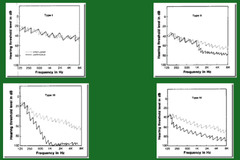
Type 1 Bekesy

answer
overlapping of tracings with excursion width approx 10dB -normal or CHL -excursion width can be reduced due to better ability to detect small intensity changes as with SISI
question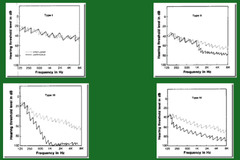
Type 2 Bekesy

answer
-at HF continuous trace falls below pulsed trace by 20dB or more -cochlear loss
question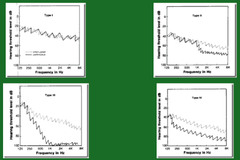
Type 3 Bekesy

answer
-tracings separate before reaching 1k & separation is at least 40-50dB or to equip limits -retro loss
question
Type 4 Bekesy
answer
-tracings separate before 1kHz but not as much separation as type 3 -retro cochlear path
question
Type 5 Bekesy
answer
-when continuous trace is better than pulsed trace -pseudohypacusis suspected
question
LOT-lengthened off time Bekesy
answer
-more likely to yield type 5 when patient faking HL -pulsed tone is 200ms on & 800ms off -harder to match loudness of tone with continous tone
question
Bekesy comfortable loudness
answer
-variation improves ID or retro path -patient traces comfort level instead of threshold -interpretation based on original 4 types
question
Advantages of Bekesy
answer
-documents patients response during test -very effective in detection of cochlear pathology -several modifications
question
disadvantages of Bekesy
answer
-$$$ of equipment/readily available -more expensive to calibrate -patients have difficult responding appropriately because of tinnitus -ID of retro involvement questioned
question
PB Max
answer
-phonetically/phonemically balanced max -highest score on psychometric function
question
PB Min/rollover
answer
-WRS or SRS worsens at higher intensities
question
what does retrocochlear pathology cause?
answer
more rollover
question
where is PB Max obtained?
answer
30-40dbSL
question
verifying PB max
answer
-search whenever initial score is 6% continue
question
when to search for PB max in standard diagnostic approach
answer
-search when WRS is poorer than expected & there is reasonable suspicion of retro pathology *lower limit=110.05+(PTA)(-1.24)*
question
Dubno forumal for NU#6 words
answer
lower limit=110.05+(PTA)(-1.24)
question
when is WRS for 1 ear significantly poorer than WRS for other ear?
answer
asymmetry suspicious for retro pathology
question
when has WRS significantly changed at retest?
answer
change is undesirable & suspicious -Thornton & Raffins 95% confidence table
question
SPRINT-speech recognition interpretation chart
answer
combines Dubno forumla & Thornton & Raffins table
question
HA prognosis for PB max
answer
-not searching for PB max -test at MCL, good scores=good prognosis poor scores=poor prognosis -establish realistic expectations
question
estimate of everyday speech understanding for PB max
answer
-presentation level for convo 50-55dBHL -not looking for PB max but for reflection of real life performance -can counteract patient denial after PB max eval leaves patient with unrealistic view of performance
question
functional gain for PB max
answer
performance with amp can be assessed in soundfield aided vs unaided at 50-55dBHL -with/without noise, cafeteria noise, babble
question
multifrequency tymp
answer
-sweeping prob tone from 200-2KHz -results in config tracings with multiple resembling V, W & inverted V -function of varying probe tone frequ
question
shapes of multifrequency tymp
answer
-becomes more complex as frequ increases -inverted v single peak pressure found with LF probe tone -inverted W multi peaked appears with mid frequ -V appears with HF probe tones above resonance frequ
question
significance of tracings for multifrequency tymp
answer
-frequ values of notching in tymp appearance -shifted towards higher frequ for ossicular fixations -frequ shifts towards lower frequ for post stapedectomy & ossicular discontinuities
question
clinical application of multifrequency tymp
answer
-distinguish between LF & HF -looks at mass, stiffness, resistance associated with disease
question
why isn't multifrequency tymp being used?
answer
-never embraced by audiologists -insufficient justification of results -cost of added feature to equipment -time is an issue -reimbursement not listed in CPT but can use tymp with modifier
question
4 patterns of admittance tymps based on?
answer
number of combined minimal & max in susceptance (B) & conductance (G) tymps
question
susceptance (B)
answer
-inverse of reactance & associated with imaginary part of admittance
question
conductance (G)
answer
-inverse of resistance -equal to real part of admittance
question
4 classifications of multi frequ tymp Van Heusen
answer
-1B1G -3B1G -3B3G -5B3G
question
1B1G tymp
answer
-both B & G tymp have a single peak -lower than resonance frequ
question
3B1G tymp
answer
G tymp single peak B has 2 max & 1 min or 3 extrema -at resonant frequ of system
question
3B3G tymp
answer
-both B & G tymps have 3 extrema -above resonance frequ
question
5B3G tymp
answer
-G tymp has 3 extrema -B tymp has 5 extrema -above resonance frequ
question
why do we need multifrequency tymp?
answer
-infants <6-7 months -226Hz probe tone, insensitive to ME -higher frequ probe tones 630Hz & 1000Hz
question
fistula
answer
-abnormal connection or passageway between 2 epithelium-lined organs or vessels -disease condition but may be surgically created for therapeutic reasons
question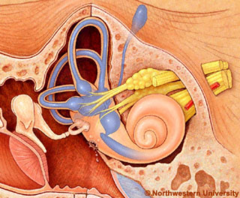
what is perilymphatic fistula?

answer
-tear or defect in 1 or both small, thin membrane between ME & IE -OW, RW separate ME from fluid filled IE -severity & complexity vary (very mild to incapacitating)
question
etiology of fistula
answer
-perilymph leaks from perilymphatic spaces of bony labyrinth into ME space -loss of perilymph alters balance between perilymph & endolymph in membranous labyrinth -can be either unilateral or bilateral -rarely occur spontaneously
question
what do you feel with fistula?
answer
-normal pressure changes now cause inner ear to be stimulated -balance system & hearing systems are adversely effected
question
symptoms of fistula
answer
-HL (LF)-can range from flat to HF, fluctuating, mostly SNHL -tinnitus -aural fullness -vertigo -disequilibrium
question
series of events for fistula
answer
-membrane rupture -rapid severe HL -loud roaring tinnitus -severe rotational vertigo: visceral symptoms=sweating, pallor, nausea, vomiting -examine nystagmus & instability -SNHL
question
diagnosis of fistula
answer
-no consensus on frequ of occurrence -how to diagnose: valsalva maneuver(hold nose & create ear pressure) -patient reports inconsistent bc of fluctuation of symptoms -treatment=surgical exploration & operative repair needed, heal on own, bed rest, elevation of head on bed, stool softeners, avoidance of Valsalva maneuver & sedation -symptoms can be masked by more serious medical problems -elusive symptamology partially responsible for controversy surrounding disorder -often depends on antecedent otologic history: surgery, trauma, diving, congenital ear malformation -trauma frequently reported
question
congenital causes of fistula
answer
-utero -birthing process
question
acquired causes of fistula
answer
-head trauma -rapid changes to intracranial pressure -atmospheric, scuba diving, airplanes, weightlifting, child birth, chronic severe infections
question
testing of fistulas
answer
-dynamic platform posturography -electrophysiology test -fistula test -imaging
question
dynamic platform posturography
answer
-pressure applied to EAC -vestibular pattern observed -abnormal sway -anterior, posterior, lateral -platform fistula test-positive
question
electrophysiology test
answer
-EcoG -intracochlear electrical potential changes associated with hearing -3 separate responses: alternating current potential, summating, action potential -2 methods of recording: transtympanic, extratympanic
question
fistula test
answer
-positive pressure to TM: possibly produce nystagmus, positive fistula test -objective record of fistula testing -ENG/VNG & impedance bridge -immittance probe placed in ear -present pressure at +200daPa decreasing to -200daPa -during change in pressure recording of eye movement is conducted for presence of nystagmus
question
imaging
answer
-MRI: gadolimium enhanced to exclude acoustic neuroma or structural lesions of cerebellar pontine angle or neuraxis -CT scan nonenhanced fine-cut CT of temporal bones in children -incidence of PLF much higher in those with congenital deformation of otic capsule -progressive or sudden loss in children with incompletely developed ear has higher risk of PLF
question
treatment of fistula
answer
-self healing: bed rest, no heavy lifting, avoid pressure changes -surgical- graft over window
question
superior canal dehiscence
answer
-OW & RW work together to regulate hearing & balance -mechanical wave is transduced into neural activity & sound is perceived -created by 3rd window -opening in bone overlying superior semicircular canal of ME
question
symptoms of superior canal dehiscence
answer
-vertigo -oscillopsia -autophony -hyperacousis -CHL -evoked by loud noises and or by maneuvers that change ME or intracranial pressure- coughing, sneezing, straining
question
characteristics of superior canal dehiscence
answer
-mean age of patient 45 yrs -unilateral -bone overlying contralateral superior canal is abnormally thin -1 of 3 bilateral but one ear has greater signs -1-2% of population have abnormally thin bone but not SCD
question
tulio phenomenon
answer
-vestibular symptoms induced by loud sounds
question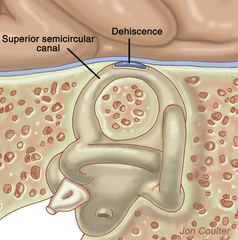
what is superior canal dehiscence associated with?

answer
-syphilis -perilymphatic fistula -congenital deafness -menieres disease -head trauma -lyme disease -cholesteatoma wit labyrthine fistula -fenestration operations
question
testing of superior canal dehiscence
answer
-vestibular evoked myogenic potentials -loud tones evoke short latency relaxation potential in ipsi sternocleidomastoid muscles -patients typically have lower than normal threshold for VEMP response & amplitude waveform is greater for comparable stimulus intensities than in ear without dehiscence
question
treatment of superior canal dehiscence
answer
-tolerate their symptoms -avoiding stimuli that make symptoms worse -surgical correction: possible side effects=possible HL
question
ipsilateral pathway
answer
-ipsi ME, cochlea, CN VIII, ventral cochlear nucleus, SOC, facial motor nucleus, CN VII -stapedius muscle in ipsi ME
question
contralateral pathway
answer
-ipsi ME, cochlea, CN VIII, ventral cochlear nucleus -contra SOC, facial motor nucleus, CN VII -stapedius in muscle of contra ME
question
presentation frequ of ipsi & contra reflex
answer
500, 1k, 2kHz 4kHz not reliable BNB
question
partial reflex thresholds
answer
-present at some frequ -absent at others
question
elevated reflex thresholds
answer
-exceed 100dB HL -result of L depends on degree of loss
question
absent reflexes
answer
-normal ME function -mild to moderate SNHL (60dB or worse) -suggest retrocochlear pathology, brainstem lesions -normal hearing sensitivity -ME disease -possible neurological involvement: CN VIII, auditory neuropathy, CN VII *if ME normal, suggests neural pathway lesion before stapedius muscle innervation*
question
ME pathologies
answer
-ME fluid -disarticulation -perforation -otosclerosis
question
ME fluid
answer
-renders stapedius muscle immobile or partially
question
disarticulation
answer
-energy can not transfer easily through ossicular chain & reflex cannot be accurately assessed -break lateral to insertion of stapedius muscle -contraction not transmitted to TM=absent reflexes in probe ear -opposite result possible: present contra reflexes with A/B gap in probe ear
question
perforation
answer
-resistance of TM compromised & contraction of stapedius muscle not occur properly
question
otosclerosis
answer
-stiffening of bones results reduced muscle contraction
question
contralateral reflex
answer
-reflex expected to be >95dBHL if loss is 45dBHL -reflex expected to be 100-115dBHL if cochlear HL is 50-70dBHL -50% patients have reflex with loss up to 80dBHL
question
cochlear disorders
answer
-related to degree of HL -less than approx 50dBHL=generally normal thresholds, IHC intact, afferent paths sufficient to activate ASR -greater than approx 50dBHL: AR threshold elevated/absent, more severe loss more difficult to distinguish between cochlear & retro -greater than 80dBHL very unlikely to have AR, IHC extensively damaged, stimulus level not sufficiently high to evoke reflex *pattern=stimulus effect* elevated or absent depending on degree of loss
question
Metz Test
answer
-comparison between ART & HL to determine cochlear or retro -diff of less than 60dB between ART & hearing threshold at same frequ was positive for cochlear HL with recruitment
question
retrochochlear/8th nerve in regards to reflex
answer
-ASR typically elevated or absent with stimulus presented to affected ear
question
unilateral ME pathology
answer
-right disordered ear= probe ear NR, abnormal function of ME, space prior to initiation of stimulus tone -non-probe ear=NR measured in disordered ear, due to abnormal ME -left normal ear= probe ear normal & no abnormality -non-probe ear=elevated response, stimulus traveling through abnormal ME space
question
bilateral ME pathology
answer
Probe ear -ipsi=absent -contra=absent -fluid: stiffening effect does not allow for change in stiffening of muscle to be recorded when reflex is activated by stimulus
question
Sensorineural loss cochlear dysfunction
answer
-depends on degree of loss -losses less than 50dbHL will typically have no effect on reflex pattern losses between 50-80dBHL reflexes may be elevated -losses greater than 80dBHL reflexes more than likely will be absent
question
retrochochlear dysfunction
answer
-CN VIII (acoustic& vestib) -disordered ear ipsi=reflexes absent contra=reflexes present -normal ear ipsi=reflexes present contra: reflexes absent
question
facial nerve dysfunction
answer
-ipsilateral absent reflexes: stapedius does not contract -contra absent reflexes: stapedius on R does not contract even with stimulation of L -normal ear= present reflexes for ipsi & contra
question
acoustic reflex decay
answer
-continuous stimulus for 10sec -500 or 1kHz -presentation at 10dBSL between 90-105dB (do not exceed 110dBHL) -stapedius muscle contracts & able to hold contraction at max ampl in normal -stapedius contracts but within 5 sec amplitude decreases more than 1/2 max amplitude
question
auditory neuropathy
answer
-etiology unclear -wide range of severity of HL & symptoms -OAE present, reflexes absent/elevated -abnormal acoustic reflexes at 1&2kHz -ipsi or contra -ABR waveform abnormal/absent
question
facial nerve lesion identification
answer
-paralysis with normal stapedial reflexes=assume can be made that nerve is normal from level proximal to brainstem -paralysis with abnormal stapedial reflexes= lesion at location or distal to pyramid turn of facial nerve
question
brainstem pathology
answer
-AR elevated/absent in retrocochlear pathologies -extra axial disorder=vestibular schwannoma, affected side elevated or absent -intra axial disorder=acoustic neuroma at level of crossing pathways, contra reflexes abnormally bilateral, ipsi reflexes normal
question
pseudohypacusis/functional loss
answer
-abnormally low ART for hearing threshold -Tonal ARTs are on effective non behavioral tool for ID functional loss -when thresholds >60dBHL -ARTs cannot ID functional component when thresholds <55dBHL
question
results of acoustic reflex decay
answer
-muscle holds contraction for more than 5 sec without decreasing more than 1/2 initial amplitude -normal, cochlear, CN VII or VIII -decay noted then may be tumor or bell's palsy
question
7th nerve involvement
answer
-proximal (central) of stapedius= probe in ear on affected side= absent -distal (more peripheral)=probe in ear on affected side=present
question
vestibular aqueduct
answer
-small bony canal -vestibule to posterior portion of petrous portion of temporal bone -contains endolymphatic duct attached to sac (fluid filled) -congenital malformation -dilation of endolymphatic duct & sac
question
what are the functions of a vestibular aqueduct?
answer
-regulate ion concentration in IE -transmission of sound & balance signals from ear to brain
question
Mondini
answer
-Italian physician -tomography -Mondini malformation=missing turn in cochlea -anatomy of cochlea
question
characteristics of enlarged vestibular aqueduct syndrome
answer
-most common ID inner ear bony malformation in children with SNHL -no unique characteristics -early onset HL -vestibular disturbance -trauma -Pendred syndrome
question
Pendred syndrome
answer
-autosomal recessive SNHL -Mondini dysphasia of cochlear -enlarged thyroid gland
question
audiologic assessment of enlarged vestibular aqueduct syndrome
answer
-auditory -vestibular -depends on age of patient & ability *case history important*
question
auditory assessment results of enlarged vestibular aqueduct syndrome
answer
-unilateral or bilateral -mild to profound -fluctuating, progressive or sudden -sloping, rising, flat, cookie bite -mixed
question
vestibular assessment results of enlarged vestibular aqueduct syndrome
answer
-mild imbalance to episodic vertigo
question
avoiding misinterpretation mismanagement of enlarged vestibular aqueduct syndrome
answer
-A/B gap can lead to misdiagnosis -computer tomography -MRI -CBC
question
caution to patient for enlarged vestibular aqueduct syndrome
answer
-avoid head trauma especially on side effected



